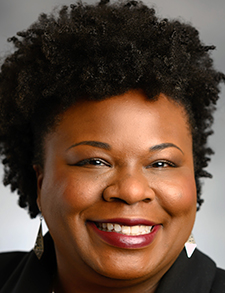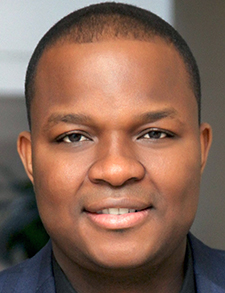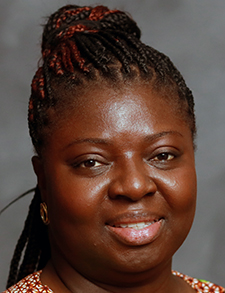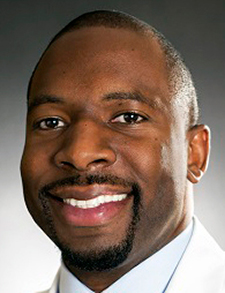In honor of Black History Month, we’re highlighting four members of the Society of Hospital Medicine (SHM) who are making a positive impact on the lives of their patients, colleagues, students, and communities. Despite having different career paths, their stories share common threads.
Teaching, inspiring, and championing the next generation of doctors

Dr. Bragg
TaLawnda Bragg, MD, FACP, internal medicine residency program director and an internal medicine hospitalist at Corewell Health in Grand Rapids, Mich., and associate clinical professor of medicine at Michigan State University College of Human Medicine, was inspired to become a hospitalist after seeing her father suffer with sickle cell disease and thalassemia. She was impressed with the care he received in the hospital, and the doctors who helped him recover became her role models. “I didn’t know much about hospital medicine back then,” said Dr. Bragg. “But to see my dad so ill, and then get better; the people in the hospital were miracle workers. Having hospital-based physicians who can navigate the acute-care world, swiftly build rapport with patients and their families, and diagnose and treat their acute illnesses through the lens of quality and safety, is priceless for patients and their families during these vulnerable times of being hospitalized.”
Witnessing the care her dad received was the catalyst that led her down the health care path. Having amazing mentors throughout her residency kept the idea of hospital medicine at the forefront. Combining teaching, learning, mentoring, and collaborating—all the things she enjoys, which happen to be the principles hospitalists embody—steered her down the academic hospital-medicine path.
“Every day I get to learn, teach, mentor, and have a hand in training the next generation of physicians,” Dr. Bragg said. “I think about the type of doctors it took to get my dad well. Witnessing that as a family member—physicians taking time, being trustworthy and culturally intelligent, and recognizing that structural determinates of health put people on uneven footing—made me want to have a role in educating medical students and training resident doctors to be just like that.”
As the program director for internal medical residency where she teaches about 45 residents and interacts with hundreds of students rotating through internal medicine, Dr. Bragg considers it her duty to stress those vital, valuable skills. “It brings me joy and hope for the future of medicine,” she said.
She credits her team—the “best team ever”—for helping to make sure Corewell Health residents get the best educational training experience possible, which helps her thrive in her career. Because of this work, she sees promise in the next generation of physicians. “When you think of who physicians used to be, that’s not who our patients need now. They need the new-age physicians, the ones involved in the communities. We need to know the people we serve; we need to meet them where they are and partner with them on their health journeys,” Dr. Bragg said.
Thriving is more than surviving, and that’s why she stresses the importance of physician well-being. Dr. Bragg tells her residents that while they’re super and amazing, they’re not superhuman. “You can’t pour from an empty cup,” she said. “We’re better for our patients and communities if we maintain our health. Physicians are human beings who need the same care, regard, and TLC that patients need. We’re turning out better physicians but how do we preserve this noble profession? Resilient?—I hate that word—we’re plenty resilient. Instead, how can we change what’s expected of physicians and the environment in which we practice so that our profession is sustainable and doesn’t deplete us? The pandemic made things more obvious, but working and being burned out, but working anyway, was always there. The pandemic just made the importance of well-being more obvious and more of a critical necessity. That has to remain a priority.”
Dr. Bragg is aware that fewer than 5.7% of all physicians are Black, and 2.7% are Black females.1,2 She believes the shortage of Black health care practitioners is a national problem and wants her colleagues to “protect us at all costs.” She wants colleagues to realize that Black physicians “are in a constant state of self-repair, bleeding from a million different paper cuts,” and their experiences as minority physicians can be very different.
People aren’t used to seeing Black physicians, let alone Black female physicians, so it’s not at all uncommon for patients to assume she’s a service worker, second-guess her diagnosis, treatment, and competency, or ask where she’s from. What she sees ranges from subtle microaggressions to flat-out racism: requesting another (white) physician—fortunately, there’s zero tolerance for racism and discrimination at Dr. Bragg’s institution.
“Listen to our stories. Learn from us,” Dr. Bragg said. “I want to be heard. We need our team members to be allies. To do that you have to listen.” The best things colleagues can do are to be supportive and realize there are experiences that Black physicians deal with because of racial biases, and to be an advocate so they feel supported.
For Black hospitalists just beginning their careers, Dr. Bragg says, get connected. She says it’s not uncommon to feel isolated as a Black physician, but you have to be open and let people get to know you. “Most Black hospitalists will find themselves as one or one of a few in their practice. Because of that, it’s very unlikely that you’ll find a senior Black hospitalist to be your mentor,” she said. “But somebody hired you; somebody believes in you and wants you to succeed. Find the person. It’s important to have someone who will have your back, especially if adversity arises. You need your people to support you.”
Dr. Bragg says she’s fortunate to be a mentoring physician and to have had many mentors who still support her. At her institution, she says when a new Black doctor joins the hospital she and other Black physicians will send an email letting them know, essentially, that they’re not alone. “We’re a small community; we have to take care of each other,” she said. “It’s an important responsibility—it will assure our survival in this area. It really is about making connections and what you can do for the next generation. Take time with Black medical students; try to help set them up for success. Be willing to be a mentor. It takes being open and brave.”
It’s also important to understand that patients need to see Black practitioners. Dr. Bragg’s been a hospitalist for 15 years and a program director for eight and she still sees Black patients in their 80s and 90s who tell her they’ve never had a Black doctor before. “People of color have not seen themselves in the people who care for them,” she said. And they need to.
What could be done to make hospital medicine more equitable and more accessible to Black practitioners? Dr. Bragg has some ideas. “We have to stop hoping Black practitioners will find us. We need to be active in the recruitment process, develop pipeline programs, buy ads, attend minority-medical-student organization conferences as recruiters, and sponsor Black medical students’ membership in professional societies. At my institution, we go to conferences and make connections with medical students. It seems simple, but we have to show them we appreciate them; we’re here and we need you.”
And, while admissions of Black students into medical school have increased, they’re the slowest-growing demographic of doctors ever.3 “Early involvement, mentorships, and collaboration can be our superpower,” Dr. Bragg said. “How can we collaborate with medical schools, high schools, even middle schools? Black students need to see Black physicians, so they know it’s an option for them. We need to be engaged in our communities.”
A transradiant mindset guides this PA

Mr. Desamours
Patrick Desamours, MSPA, PA-C, MBA, CHCQM, SFHM, is the director of APP operations in hospital medicine at US AcuteCare Solutions in Westminster, Md. His journey to becoming a physician assistant (PA) started during clinical rotations where he experienced diverse disciplines, but was particularly drawn to the acuity, diversity, and teamwork of hospital medicine. After passing his board, he worked at a hospital in Baltimore where he began experiencing the complexity of hospital medicine beyond medicine. He joined SHM to enhance his experience and grow professionally, investing in documentation, billing, and quality education.
Mr. Desamours attributes his ability to flourish and be successful to his wife’s support, networking with other hospital medicine professionals, caring for patients, and his positive mindset. “My wife helps me thrive beyond measure,” he said. “We started our careers around the same time. Our stressful days at work became normal conversations over dinner. She believes in me, and my ability, and her support and prayers keep me going daily.”
Networking with others, he says, you meet people who make you feel like you’ve chosen the wrong profession and others who become family—both are needed for growth. He approaches every challenge with a “transradiant mindset—a mental frame of my goals and values with a laser-like focus that propels me toward my objectives.”
In our current climate of misinformation and increased occupational violence, Mr. Desamours hopes his colleagues understand that sometimes Black practitioners have to work twice as hard to prove their credibility. “We’re often misidentified and misunderstood,” he said. “I wish they would realize that passion is not aggression, and being a bit louder isn’t inappropriate. There’s nothing more demoralizing than microaggressions.”
Mr. Desamours advises Black hospital medicine professionals just starting their careers to embrace their identity, set goals and objectives for their career path, define their success and happiness, build resilience, and deal with conflict with love and grace. “America is still grappling with issues of race, colorism, gender, political affiliations, etc.,” he said. “These are obstacles for you to make a difference in your career. Everyone has prejudices and biases; raise yourself above them. Patient care is your top priority; don’t let anyone or anything interfere with that. You have a life to save–that is a higher calling than any insult you could receive.”
When it comes to making hospital medicine more equitable and accessible to Black practitioners, Mr. Desamours believes that everyone is equal and that it’s time to give people the ability to have the full human experience. “We should treat people with dignity. With all fairness, many people live their entire lives around people who look like them and they want to be around those people. This is commonality; commonality is not racism,” he said. “These people deserve to have adequate education to help them understand that there’s a bigger world outside theirs. This is where implicit bias training, diversity and inclusion programs, transparent hiring practices, and cultural competency training can be very powerful if implemented properly. These efforts enhance equity and accessibility for Black hospitalists.”
Pediatric hospitalist advises being your authentic self

Dr. Cobinna
Ekua Cobinna, MD, is a pediatric hospitalist at Loma Linda University Children’s Hospital and an assistant professor of pediatrics at Loma Linda University in Loma Linda, Calif.
She was born in Accra, Ghana, to a family of academics and raised to have a can-do attitude. Growing up, she always knew she wanted to work with children. She immigrated to the U.S. in 1996 and obtained her undergraduate and medical degrees from Creighton University in Omaha, Neb. She naturally gravitated toward pediatrics and completed her pediatric residency at Loma Linda University Children’s Hospital.
During her residency, Dr. Cobinna enjoyed inpatient patient care, but there was no dedicated hospital-medicine service at the time. “Pediatric hospital medicine was in its infancy and not as common,” she said. “I heard about pediatric hospitalist work while searching for a job. I was very intrigued, which started my journey as a pediatric hospitalist with a small private group in the Phoenix Metro area.” She later returned to academic medicine at Loma Linda University Children’s Hospital, where she was a founding member and is now associate division chief for hospital medicine of its rapidly growing pediatric hospitalist team. The team has grown from seven to more than 30 physicians in the last five years.
Dr. Cobinna credits her family, especially her mother, and her upbringing as the primary cornerstone of who she is. She was raised to believe there was no limit to what she could do if she put her mind and hard work into it. “However, in my professional journey, I have had countless mentors from different backgrounds (most of whom did not look like me) who were invested in my success and guided my growth in this challenging field,” she said.
Being a Black female physician has many challenges that she initially attributed to being a resident during her training. She wishes she had some mentorship in this area during her training. “As a Black female physician, the challenges are both invisible and super visible, as described by Cecil Reed in his book, Fly in the Buttermilk,” Dr. Cobinna said. “We face ‘hyper scrutiny’ and often must be hypervigilant in navigating what Cody Stanford referred to in The Lancet as a version of the Goldilocks dilemma: ‘They are either insufficient and unsuitable, or boastful and overdone – never just right.’” She’s grateful for friends, family, and colleagues who are pioneering and spearheading thoughtful conversations to foster first awareness and cross-cultural relationships.
Dr. Cobinna advises Black hospitalists who are just beginning their careers to be “Be patient, open-minded, and your authentic self. Put your best foot forward, work hard, and the sky is the limit.”
She believes there are several ways to make hospital medicine more equitable and accessible to Black hospitalists. These include investing in education around awareness of inequities, increasing the diversity of physicians (via recruitment efforts), and funding scholarships to improve research in healthcare equity (both physician- and patient-facing). Additionally, she suggests engaging with a younger generation of physicians, coaching and mentoring them and placing early-career physicians in leadership positions to facilitate consistent growth in the program. Being intentional about highlighting Black physicians doing amazing work at their institution and beyond is also crucial.
According to Dr. Cobinna, funding pipeline programming to support future generations of hospitalists and physicians overall is critical to long-term stability.
“Diversity and inclusion are not simply buzzwords in today’s society; they are essential pillars that should be embraced within every aspect of our lives, including health care. Fostering diversity and promoting inclusion is crucial for providing equitable access to and delivery of quality care,” she said. “An orchestra comprises various instruments, each unique in tone and character, coming together harmoniously to create something beautiful. Similarly, diversity and inclusion in health care bring together individuals from different backgrounds, experiences, and perspectives to create a harmonious, inclusive, and effective health care system.”
Caring for patients in rural areas

Dr. Dawkins
Bryan Dawkins, MD, is vice president of hospital services of Elite Medical Services and a family physician and faculty member in inpatient family medicine in the family-medicine residency program at Lakeside Medical Center, which is an acute-care teaching hospital in rural Belle Glade, Fla.
Dr. Dawkins was inspired to become a hospitalist because of his upbringing in Jamaica and his move to the U.S. when he was 10 years old. He credits his parents, who were devoted to education and community service, for instilling in him a passion for medicine. He attended Howard University in Washington, which not only provided him with a strong medical education but also fostered a sense of identity and purpose as a Black practitioner.
Currently, he’s working as a hospitalist and faculty member of a family-medicine residency in Belle Glade, a rural and underserved area of South Florida, where he is dedicated to improving accessible health care.
He attributes his success as a hospitalist to a combination of factors including unwavering support from his family, belief of mentors in his potential, and a strong sense of community. “These interconnected factors not only advanced my professional journey but also played a significant role in fostering a sense of belonging in a field where diversity is often lacking,” Dr. Dawkins said.
For colleagues who may not share the same experiences, Dr. Dawkins wants them to recognize the valuable perspectives and insights that Black health care professionals bring to the table. “Our diverse backgrounds enrich patient care, allowing for a more comprehensive and culturally sensitive approach,” he said. “Acknowledging and valuing these differences can lead to a more inclusive and effective health care system.”
“To my fellow Black hospitalists in the early stages of your careers, I advise staying true to your roots and the passion that led you to pursue medicine,” Dr. Dawkins said. “Seek out mentors who understand and appreciate your unique journey, and don’t hesitate to be a trailblazer. Embrace challenges as opportunities for growth and development, recognizing that your presence in this field is not only necessary but transformative.”
To ensure equitable access to hospital medicine for Black practitioners, Dr. Dawkins believes it is essential to address systemic issues contributing to inequality. Initiatives such as mentorship programs, diversity and inclusion training, and increased representation in leadership roles can create a supportive and inclusive environment. “Advocating for policies that promote equal opportunities and eliminate bias in hiring and promotions is critical for lasting change,” he said. “Through collective efforts, the goal is to make Black History Month not only a time for reflection but a catalyst for meaningful change in the medical field.”
References
- Boyle P. What’s your specialty? New data show the choices of America’s doctors by gender, race, and age. Association of American Medical Colleges website. https://www.aamc.org/news/what-s-your-specialty-new-data-show-choices-america-s-doctors-gender-race-and-age. Published January 12, 2023. Accessed December 30, 2023.
- Rivero E. Proportion of Black physicians in U.S. has changed little in 120 years, UCLA research finds. News release. University of California, Los Angeles website. https://newsroom.ucla.edu/releases/proportion-black-physicians-little-change. Published April 19, 2021. Accessed December 30, 2023.
- Medical school enrollment more diverse in 2021. News release. Association of American Medical Colleges website. https://www.aamc.org/news/press-releases/medical-school-enrollment-more-diverse-2021. Published December 8, 2021. Accessed December 30, 2023.